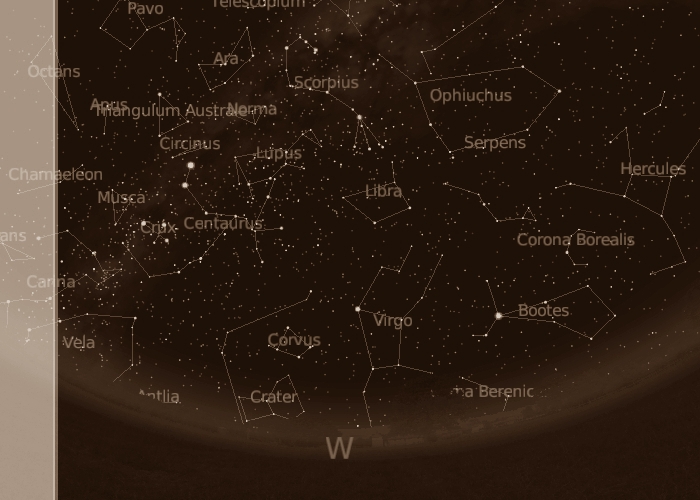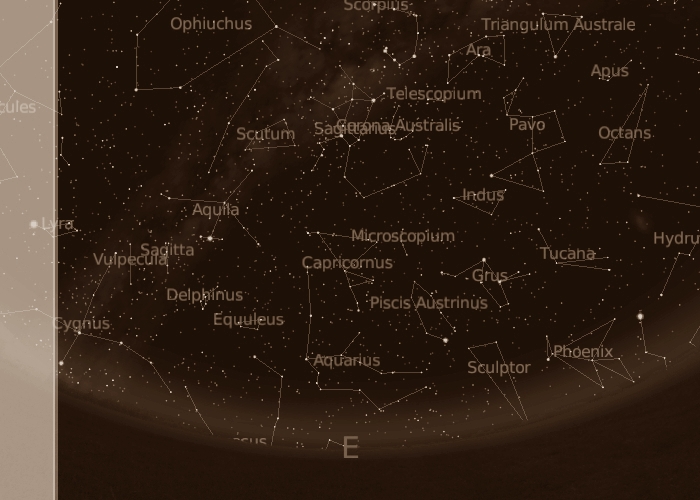Western Horizon
Eastern Horizon
Precisions About Daylight Saving Time (DST) Adjustments
![]()
Western Horizon
Eastern Horizon
Precisions About Daylight Saving Time (DST) Adjustments

We're in winter now! The show, in winter, in the southern hemisphere, is southwest and West! With a part of the Milky Way-embedded, typical band of southern constellations, which is seen, from a part of Carina, the Ship's Keel, to, high, Scorpius, the scorpius. The two bright stars high, southwest, are the famed 'Pointers', those both stars 'pointing' to Crux, the Southern Cross. One of those is Alpha Centauri, the system of stars, of which one star is the nearest star to our Sun, at 4.3 light-years, as it's called 'Proxima Centauri'. The fainter constellation below Scorpius and the arch of stars ahead of the red Antares, is Libra, the Scales, which was long hold to represent the insect's claws. That way, in the southern hemisphere, scorpius is well seen like representing the figure it's supposed to do. The bright star, northwest, is Arcturus, of Bootes, the Herdsman, as West, you'll find Spica of Virgo, the Virgin. Hercules, the Heroe, is northwest further, providing possibly to the view of M13, this famed globular cluster. Corona Borealis, the Northern Crow, is another fine sight in the region. to a printer-friendly chart
West for the tropics. West for the mid-northern latitudes

Let's turn East now, with a flurry of typicall southern constellations seen southeast, from Pavo, the Peacok, high, to Piscis Austrinus, the Southern Fish, or Grus, the Crane or, lower, part of Phoenix, the Phoenix. The bright star in the Southern Fish is the famed Fomalhaut, the name of which, in Arabic, means the 'fish's mouth'. Capricornus is full East, well placed for observation, as, northeast, another fine show is provided now, with the famed, typically northern 'Summer Triangle'. The Summer Triangle is the distinctive feature of the skies, during summer, in the northern hemisphere. It owes its name to that it's a large triangle, composed of three bright stars. Those are the main stars to the constelations of Lyra, the Lyra, Cygnus, the Swan, and Aquila, the Eagle. Small, associated constellations, like Sagitta, the Arrow, Delphinus, the Dolphin, or Equuleus, the Little Horse, are seen in the vicinity. Fine sights! High, North, you'll be able to spot Ophiuchus, the Serpent Holder. to a printer-friendly chart
East for the tropics. East for the mid-northern latitudes
Some countries in the southern hemisphere don't have any Daylight Saving Time system. Some do have one. According to the policy of our site, our sky charts include a one-hour DST shift for the period September to March. Should your DST period differ, just adjust the charts. Should you not have any DST, take in account that one-hour DST shift we are applying September-March
For more details upon whether you country is applying, and when, a DST, please check a search engine on the Internet, for example!
Website Manager: G. Guichard, site 'Amateur Astronomy,' http://stars5.6te.net. Page Editor: G. Guichard. last edited: 12/28/2010. contact us at ggwebsites@outlook.com